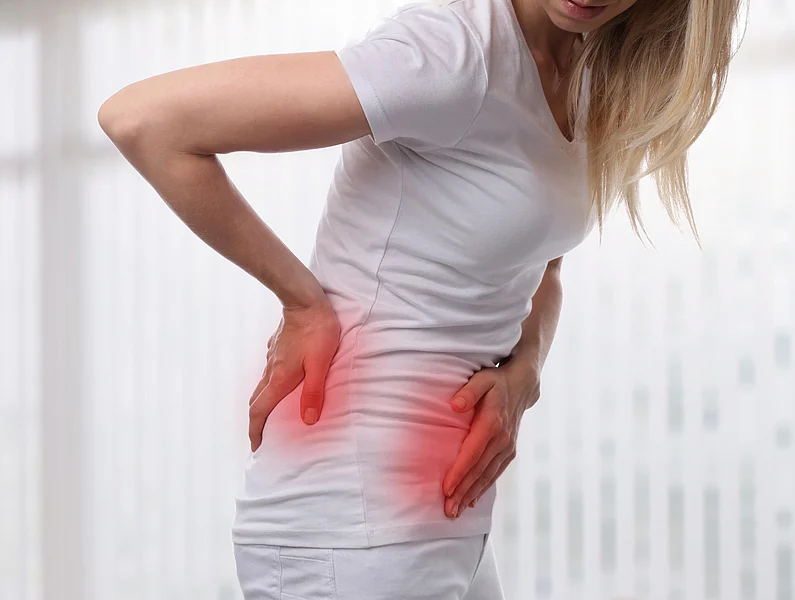Get Healthy!

- Alan Mozes
- Posted October 12, 2022
Kidney Stones Can Be Excruciating. New Treatment Blasts Them Away, No Anesthesia Needed
A new ultrasound treatment for kidney stones might provide pain-free relief while the patient is awake, researchers say.
Kidney stones are often excruciatingly painful. In most cases, patients are told to just ride it out, sometimes for weeks, in the hope the stone will eventually pass through the urinary tract -- from kidney to bladder -- on its own. But for roughly one in four patients that never happens, triggering surgical intervention.
However, a small new study suggests there may be another way: a non-surgical and minimally painful treatment that enlists two types of ultrasound to zap "ureteral stones,"causing them to break up, dislodge and reposition in order to make passing the stones easier and faster.
"The two-pronged approach is to first break the stone into fragments and then move the fragments toward the exit so they will pass,"explained study author Dr. M. Kennedy Hall. He is a professor in the emergency medicine department at the University of Washington School of Medicine, in Seattle.
The goal, said Hall, is "to remove the stone right away, when you first come to the doctor, so you don't sit home in pain and anxiety,"unsure if invasive surgery -- complete with anesthesia -- is in the offing.
In the study, Hall's team focused on the potential of combining two different ultrasound tools: ultrasonic propulsion (UP) and burst wave lithotripsy (BWL).
The idea stemmed from a NASA-led effort to develop a non-sedation approach to kidney stones for astronauts on long-haul trips.
Ultrasonic propulsion is designed to help move and reposition the problem stone, while BWL is deployed to break up the stone into smaller pieces.
The authors pointed out that a third procedure -- called shock wave lithotripsy -- is already a go-to when surgery is called for. But it requires sedation, and is decidedly not pain-free.
Dr. Arash Akhavein is a urologist with Cedars-Sinai Medical Center in Los Angeles. He said the shockwave approach is essentially an invasive way to "pulverize the stone and allow passage."
Other standard treatments include the insertion of "a special endoscope through the urethra and urinary channels to find and break the stones with a laser, and/or to remove stone fragments with a special basket through the scope,"added Akhavein, who was not involved in the study.
And for particularly large stones, "we puncture a small hole in the back into the kidney to break the stone and remove the pieces,"he noted.
"Each method has indications and is suitable for certain cases. All require a trip to the operating room, almost always with general anesthesia,"Akhavein explained.
By contrast, ultrasonic propulsion and BWL can be performed while patients are awake, whether in an emergency room or a clinic setting. And according to Hall and his associates, both techniques are essentially "painless."
To see how well the dual ultrasound approach might work, the investigators enlisted 29 patients in 2018, treating 16 with propulsion alone and 13 with it and BWL.
Both techniques utilize different buttons on the same ultrasound machine, Hall noted.
In the new study, ultrasonic propulsion triggered stone movement in 19 of 29 patients. In two cases, the stones were actually pushed out of the urinary tract all the way into the bladder, providing immediate relief in one patient.
The team also found that BWL had effectively broken stones up in seven out of 13 UP/BWL patients, typically in 10 minutes or less, Hall noted.
And over two weeks following ultrasound treatment, stones passed out of the body in 18 out of 21 patients, all of whom had stones closer to their bladder than to their kidney. For this group, on average, full stone passage took four days post-procedure.
No serious side effects were observed, and pain levels were markedly lower after ultrasound, overall. Those who did not get the desired result went in for standard surgery.
The team cautioned that the findings are preliminary, and more study will be needed with a larger group of patients.
Hall said if all goes well, he could see the two techniques becoming a viable patient option within two to three years.
And that will likely be of help for kidney stone patients, Akhavein said, particularly for those with relatively small stones.
The findings were published in the November issue of The Journal of Urology.
More information
There's more on kidney stones at the National Kidney Foundation.
SOURCES: M. Kennedy Hall, MD, MHS, professor, department of emergency medicine, University of Washington School of Medicine, Seattle; Arash Akhavein, MD, urologist, Cedars-Sinai Medical Center, Los Angeles; The Journal of Urology, November 2022







